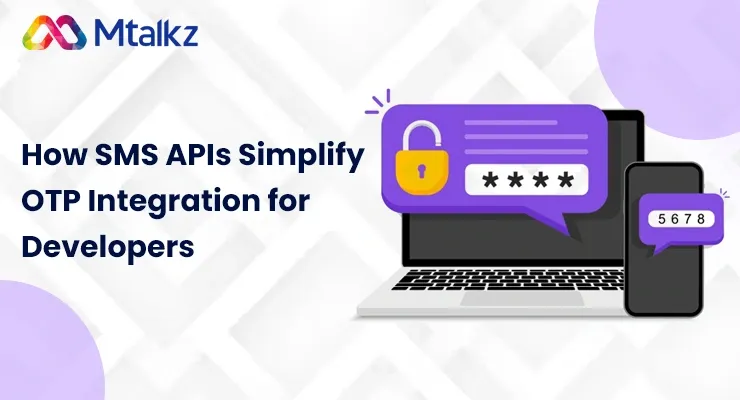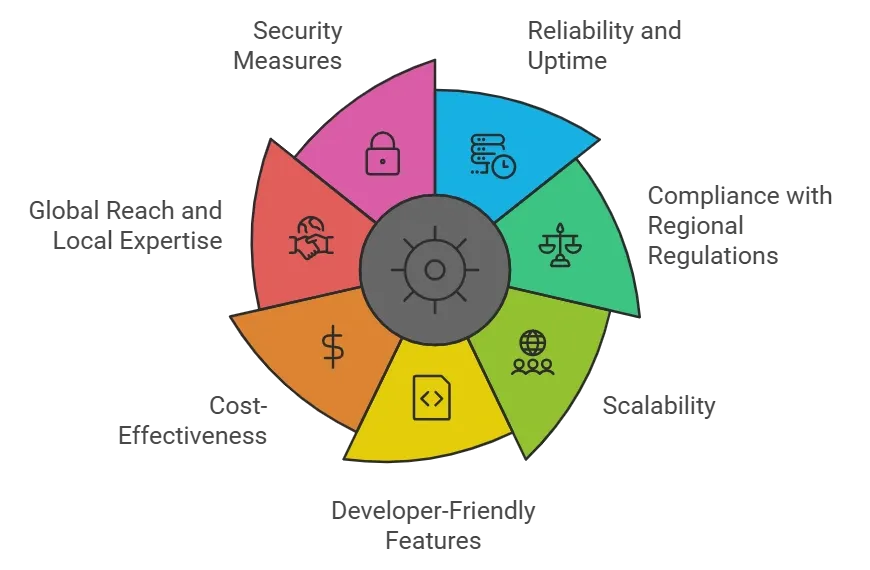
Blog
How SMS APIs Simplify OTP Integration for Developers
Learn how SMS APIs streamline OTP integration for developers by enabling fast, secure, and scalable authentication processes.
S
Shelly Prakash
•A Step-by-Step Guide to OTP Integration Using SMS APIs
Introduction
In today’s fast-paced digital landscape, user authentication has become a cornerstone of security. Whether it’s verifying a new account or securing transactions, OTPs (One-Time Passwords) offer a quick and reliable way to protect sensitive information. But for developers, implementing OTP functionality can be a tedious task without the right tools. This is where SMS APIs step in. They streamline the entire process—offering developers a fast, reliable, and scalable solution for OTP generation and delivery.
In this blog, we’ll explore how SMS APIs simplify OTP integration, providing step-by-step insights to make implementation seamless for developers.
This is where SMS APIs step in. They streamline the entire process—offering developers a fast, reliable, and scalable solution for OTP generation and delivery.
In this blog, we’ll explore how SMS APIs simplify OTP integration, providing step-by-step insights to make implementation seamless for developers.
What is an SMS API for OTP Integration?
An SMS API (Application Programming Interface) is a tool that allows developers to programmatically send and receive SMS messages. When it comes to OTP integration, an SMS API ensures that One-Time Passwords are delivered quickly and reliably to users’ mobile phones. For developers, the primary advantage lies in simplicity. Instead of building an SMS infrastructure from scratch, you can use an SMS API to integrate messaging capabilities directly into your application.
This reduces development time and ensures high deliverability through established telecom networks.
Here are the key benefits of using SMS APIs for OTP integration:
For developers, the primary advantage lies in simplicity. Instead of building an SMS infrastructure from scratch, you can use an SMS API to integrate messaging capabilities directly into your application.
This reduces development time and ensures high deliverability through established telecom networks.
Here are the key benefits of using SMS APIs for OTP integration:
- Automation: Automatically generate and send OTPs without manual intervention.
- Scalability: Handle thousands of OTP requests per second with ease, ideal for growing applications.
- Global Reach: Deliver OTPs to users anywhere in the world, including India, through a reliable mobile OTP verification API.
Why Choose SMS APIs for OTP Authentication?
 Integrating OTP authentication into your application is essential for secure user verification. SMS APIs simplify this process while offering a host of advantages tailored to developers’ needs. Here’s why SMS APIs are the preferred solution:
Integrating OTP authentication into your application is essential for secure user verification. SMS APIs simplify this process while offering a host of advantages tailored to developers’ needs. Here’s why SMS APIs are the preferred solution:
Ease of Integration
SMS APIs come with detailed documentation, pre-built SDKs, and code snippets for popular programming languages like Python, PHP, and JavaScript. Developers can quickly integrate OTP functionality without diving into complex telecom protocols.Real-Time Delivery
Time-sensitive OTPs require instant delivery. SMS APIs leverage high-speed gateways to ensure OTPs reach users within seconds, providing a seamless authentication experience.Cost-Effective Solutions
Many SMS API providers offer free OTP verification APIs for testing. This allows developers to experiment and build prototypes without upfront costs. Once the system is ready for production, scalable pricing options are available.Broad Device Coverage
SMS APIs support all mobile devices, including basic feature phones, ensuring universal accessibility. Unlike app-based notifications, SMS works without requiring an active internet connection.Global and Local Compliance
In regions like India, SMS APIs adhere to strict compliance standards, such as DLT regulations, ensuring that OTPs are sent through authorized channels. By choosing an SMS API, you as a developer can focus on building user-friendly applications without worrying about the complexities of OTP delivery. Up next, we’ll explore the must-have features of a good OTP API to help you make the right choice.Key Features of a Good OTP API
 Not all SMS APIs are created equal. When choosing an API for OTP integration, it’s essential to prioritize features that ensure reliability, security, and ease of use.
Here are the must-have features to look for in an OTP API:
Not all SMS APIs are created equal. When choosing an API for OTP integration, it’s essential to prioritize features that ensure reliability, security, and ease of use.
Here are the must-have features to look for in an OTP API:
High Deliverability Rates
A good OTP API ensures that messages reach recipients quickly and reliably, even during peak times. Look for APIs with strong telecom partnerships and redundant routing to minimize delivery failures.Customizable OTP Formats
Flexibility to define OTP lengths, formats (numeric or alphanumeric), and expiration times is crucial for meeting specific application requirements.Secure Encryption
Security is non-negotiable for OTP delivery. APIs should encrypt sensitive data, such as API keys and OTPs, to prevent unauthorized access during transmission.Compliance with Regional Regulations
In India, DLT registration is mandatory for sending transactional SMS like OTPs. A reliable API should ensure compliance with such regulations to avoid delivery interruptions.Real-Time Reporting and Analytics
Monitoring OTP delivery status is critical for debugging and optimizing performance. APIs with detailed reporting dashboards or real-time callbacks can help developers track message delivery rates and troubleshoot issues.Multi-Platform Support
APIs should offer libraries or SDKs for major programming languages and platforms, including Android, iOS, and web applications. This reduces development time and effort for cross-platform projects.Testing Environment
Free OTP APIs for testing allow developers to simulate OTP delivery without incurring costs. This is particularly useful during development and debugging phases. A well-equipped OTP API not only simplifies integration but also enhances user experience by ensuring fast and secure OTP delivery. In the next section, we’ll break down how developers can integrate an SMS API for OTPs step by step.How SMS APIs Simplify OTP Integration for Developers
Integrating OTP functionality into an application can seem daunting, but SMS APIs make it straightforward. Here’s a step-by-step guide to implementing OTP integration using an SMS API:Step 1: Choose the Right SMS API Provider
Start by selecting a provider that offers:- High deliverability rates.
- Free OTP verification API for testing.
- Clear documentation and developer support.
Step 2: Set Up Your Developer Account
Register with your chosen provider and set up a developer account. Generate API keys or authentication tokens, which are necessary to interact with the API.Step 3: Generate OTPs Using the API
Use the API to programmatically create and send OTPs. Here’s an example in Python: import requests import json url = "https://msg.mtalkz.com//V2/http-api-sms.php payload = json.dumps({ "apikey": "5XgHXxxrjKXXxNXxu", "senderid": "MTALKZ", "number": "84XX76XXX5", "message": "{OTP} is your OTP for XXX System. Please use it before XXX Team", "format": "json", "digit": "6", "otptimeout": "120" }) headers = { 'Content-Type': 'application/json', } response = requests.request("POST", url, headers=headers, data=payload) print(response.text)Step 4: Validate OTPs
Create a backend logic to verify the OTP input by the user. Most APIs provide an endpoint for validation. import requests import json url = "http://msg.mtalkz.com/V2/http-verifysms-api.php" payload = json.dumps({ "apikey": "dXXRYXxxo4sxxXXex", "sessionid": "txxs-XzX1-xxx2-Xixy-ZXsX", "otp": "4XX6X7", "format": "json" }) headers = { 'Content-Type': 'application/json', } response = requests.request("POST", url, headers=headers, data=payload) print(response.text)Step 5: Test and Debug
Leverage the free testing environment offered by many providers to simulate OTP generation and delivery. Monitor delivery reports to identify and resolve any issues.Step 6: Go Live
Once testing is complete, move to production. Ensure your application is ready to handle a high volume of OTP requests, especially during peak times. By following these steps, developers can implement OTP functionality in just a few hours, leveraging the reliability and scalability of SMS APIs. In the next section, we’ll dive into real-world use cases where SMS APIs shine.Use Cases of OTP SMS APIs
OTP SMS APIs are versatile tools that cater to a wide range of applications, ensuring secure and seamless user experiences. Here are some of the most common use cases:1. Login Authentication and Password Resets
- Purpose: Secure user accounts by verifying their identity during login or when resetting a password.
- Example: When a user attempts to log in, an OTP is sent to their registered mobile number. They must input the OTP within a specified time to access their account.
2. New User Onboarding
- Purpose: Validate phone numbers during the registration process to ensure users provide accurate contact information.
- Example: E-commerce platforms or fintech apps send OTPs to confirm mobile numbers before account activation.
3. Transaction Verification
- Purpose: Protect sensitive operations, such as online payments, by adding an extra layer of security.
- Example: Banking and payment apps use OTPs for two-factor authentication (2FA) when processing high-value transactions.
4. Subscription Confirmations
- Purpose: Verify user consent for newsletters, premium subscriptions, or services.
- Example: Before activating a subscription, a service sends an OTP to confirm the user’s intent.
5. Secure Access to Restricted Content
- Purpose: Grant temporary access to specific content or services upon OTP verification.
- Example: Educational platforms or SaaS tools use OTPs to verify users before giving access to paid features.
6. Account Re-verification
- Purpose: Periodically confirm user identity for security or regulatory compliance.
- Example: Financial apps might request OTP verification during account updates or audits.
7. Customer Retention Campaigns
- Purpose: Use OTPs to re-engage inactive users or secure offers.
- Example: Send limited-time discounts that require OTP validation to claim, ensuring genuine user interest.
How to Choose the Right SMS API Provider for OTP Integration
 Selecting the right SMS API provider is a critical step in ensuring seamless OTP delivery and user authentication. Here’s a checklist to help you make an informed decision:
Selecting the right SMS API provider is a critical step in ensuring seamless OTP delivery and user authentication. Here’s a checklist to help you make an informed decision:
1. Reliability and Uptime
- Why It Matters: OTPs are time-sensitive. Delayed or failed messages can result in poor user experiences and lost trust.
- What to Look For: Providers with a high uptime SLA (99.9% or higher) and redundant SMS gateways to minimize disruptions.
2. Compliance with Regional Regulations
- Why It Matters: Sending OTPs in regions like India requires adherence to government regulations like DLT.
- What to Look For: Providers that ensure compliance with regional telecom standards and offer support for mandatory registrations.
3. Scalability
- Why It Matters: As your user base grows, your SMS traffic will increase. A scalable solution ensures smooth performance even during high-demand periods.
- What to Look For: APIs that can handle millions of requests per second without compromising on delivery speed.
4. Developer-Friendly Features
- Why It Matters: A robust developer experience can save time during integration and troubleshooting.
- What to Look For: Detailed API documentation, SDKs for multiple languages, sample code, and responsive technical support.
5. Cost-Effectiveness
- Why It Matters: Balancing cost and functionality is crucial, especially for startups and developers working on tight budgets.
- What to Look For: Free OTP API options for testing and competitive pricing models for production.
6. Global Reach and Local Expertise
- Why It Matters: If your app serves users in multiple regions, you need an API that offers global SMS delivery with local expertise.
- What to Look For: Providers with strong international carrier partnerships and localized features like language support or time zone adjustments.
7. Security Measures
- Why It Matters: OTPs deal with sensitive data. Strong security protocols protect your application and users from vulnerabilities.
- What to Look For: Providers offering end-to-end encryption, HTTPS support, and secure storage of API keys.
Conclusion
Integrating OTP functionality into your application doesn’t have to be a complex process. With SMS APIs, developers can streamline user verification, enhance security, and ensure seamless authentication for their applications. From real-time delivery and scalability to compliance and robust documentation, SMS APIs offer the perfect balance of simplicity and efficiency for developers. At Mtalkz, we specialize in helping developers implement secure and reliable OTP solutions tailored to their needs. With our high-performance SMS API, you gain access to:- Free OTP credits for testing.
- Compliance with regulations like DLT in India.
- 24x7 expert support to assist with API integration.